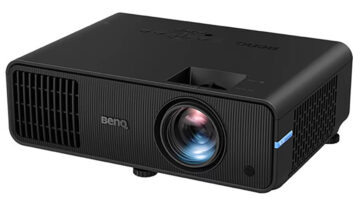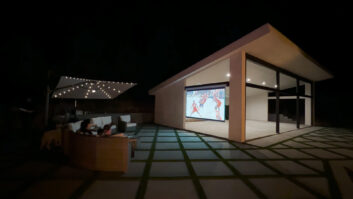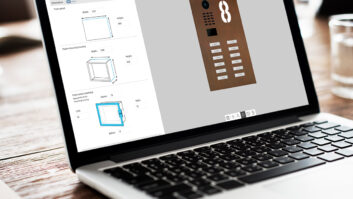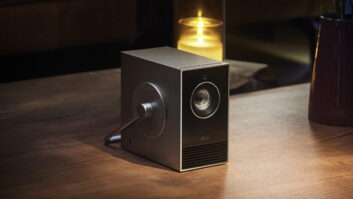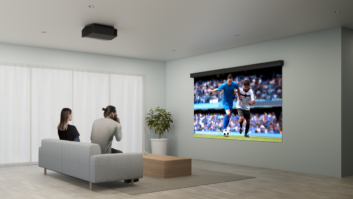What we have here is a case of honesty as detriment. JVC’s effort to be realistic, perhaps even honest, in its marketing, has resulted in a string of excellent projectors that on paper seem lackluster. Take the DLA-X30. JVC claims a contrast ratio of 50,000:1. They smartly, and rightly, point out that this is the native contrast ratio. This is what the projector does without the assist of adjustable irises, variable lamps, or other trickery. The problem is that most people shop on numbers alone. So when the competition boasts 1,000,000:1 this and a googleplex:1 that, 50,000 seems paltry.

Aesthetically, the simple exterior of JVC ‘s X30 belies the performance within.
The truth, however, is the opposite. Over the past several years, JVC’s D-ILA projectors have produced the best contrast ratios I’ve measured with any display technology. There’s no agreed upon standard to measure contrast ratio, so manufactures can make up whatever numbers they see fit. I, however, measure it in about as sane a way as I can devise: a 0 percent black image and a 100 percent white image, from the same source, in the same picture mode, after a full calibration. Done in a reasonable method like this, good displays will measure in the low thousands-to-one, really good displays will measure in the teens-to-one range. The X30? How about 28,544:1. That’s among the best I’ve ever measured.
Aesthetically, the X30’s simple exterior belies the performance within. The black cabinet has few visual flourishes, but for something that’s likely going to sit on the ceiling, flamboyant and flashy aren’t necessary. Motorized zoom, lens shift, and focus make setup simple. It’s quiet enough that you don’t need a softbox though, which is impressive. The remote has a great rubberized texture, and its backlighting is activated by a glow-in-the-dark button. Direct input access and a dedicated button for the lens memory are all there for those going to use the remote.
Lens memory is one of my favorite features; an auto lens shift with three user-set presets allows you to program different zoom/shift settings depending on your screen and the movie. I have a 2.35:1 aspect ratio screen, of which I normally use just the center 16×9 (1.78:1) section for HDTV. If I want to fill the screen, I either need to use an anamorphic lens, or manually zoom the projector out. With the lens memory feature, the projector automatically zooms out and re-shifts to fill the full screen. It seems pretty spot on. However, if you’re pedantic for perfect pixel placement, the projector ends its lens shift shuffle in the adjustment mode, with a green line pattern for you to fudge the final few millimeters.
Given JVC’s prowess with contrast, I figured I’d test that first. The most recent Star Trek movie certainly works great for testing black levels and contrast. The inky blacks of space disappeared into the darkness of the room, while at the same time, the stars, exquisite planets, and gorgeous ships brightly popped. Try doing that with an LCD or DLP. Though the basic picture settings were pretty close to accurate, I recommend turning down the sharpness control, as this adds a bit of noise, but little actual “sharpness.”
The colors, however, are off slightly from the HDTV standard: green is slightly yellowish-green, and red is slightly oversaturated. They’re close enough though that this doesn’t negatively impact the image. Scaling up from DVD or other standarddefinition sources is ok, but a decent scaling Blu-ray player will likely do better.

The JVC X30 features two HDMI and one component input, an RS-232 jack, a 12-volt trigger input, remote in, and an Ethernet port.
If you’re going the 3D route, you’ll need the PKEM1 IR 3D emitter ($97.99) and the PK-AG2 glasses ($179). The emitter is about the size of a deck of cards and connects to the projector via a proprietary cable. It bounces off the screen just fine, so you shouldn’t need to mount it too far from the projector (a swivel stand is included). The glasses are USB rechargeable, quite light, and fairly comfortable.
For outright 3D fun, the family Christmas classic A Very Harold & Kumar 3D Christmas is a treat. The 3D effect is well pronounced, but there is some crosstalk you really can’t get rid of. If the 2D performance is an “A,” 3D is more like a “C+.” I suppose some grade curve should be in place, as I’ve yet to see an “A” 3D at home.
A dark, murky film like Harry Potter and the Deathly Hallows: Part 2 perhaps best shows off this projector’s strengths. The blacks really disappear into the surrounding room, making the bright explosions and effects really burst with light. It’s truly excellent and highly cinematic.
At $3,499.95, the DLA-X30 faces some stiff competition except in contrast ratio, which is the biggest battle. For everything other than 3D, the X30 is hard to beat; the picture is just that good.
973.317.5000
www.jvc.com
Kudos
An excellent contrast ratio makes for an incredible image. Overall, one of the best projectors going.
Concerns
Adding 3D glasses and the emitter gets pricy, and 3D performance itself is fairly average.
Product Specs
• 50,000:1 native contrast ratio
• 1,300 lumens
• 120 Hz “Clear Motion Drive”
• 20 dB in normal lamp mode
• 80 percent (V) 34 percent (H) lens shift
• HDMI (2), Component (1), RS-232, 12 v trigger, Remote in, Ethernet
• 2-year warranty
